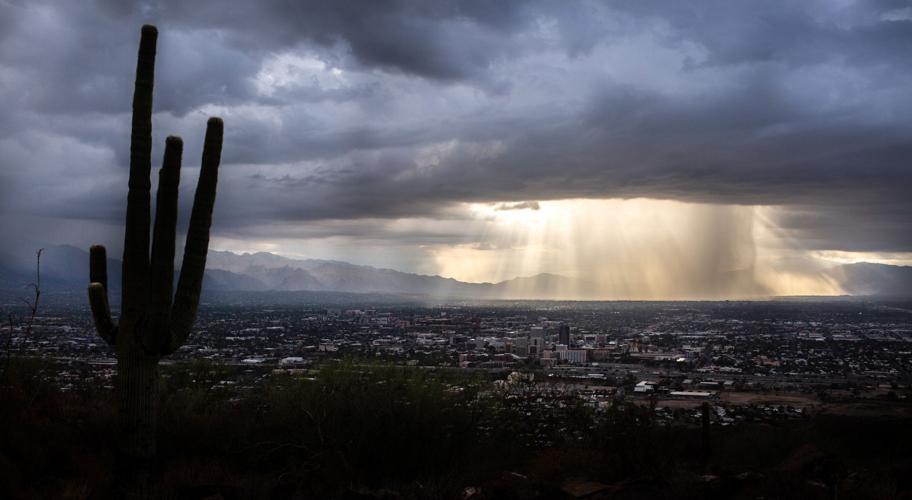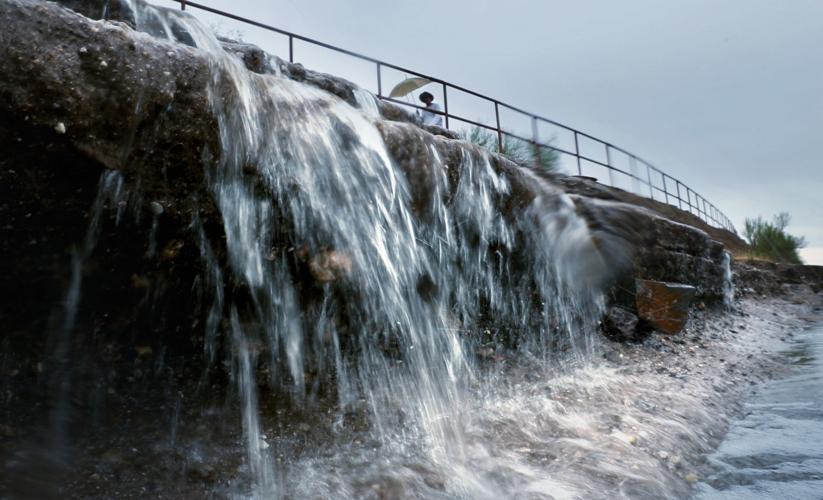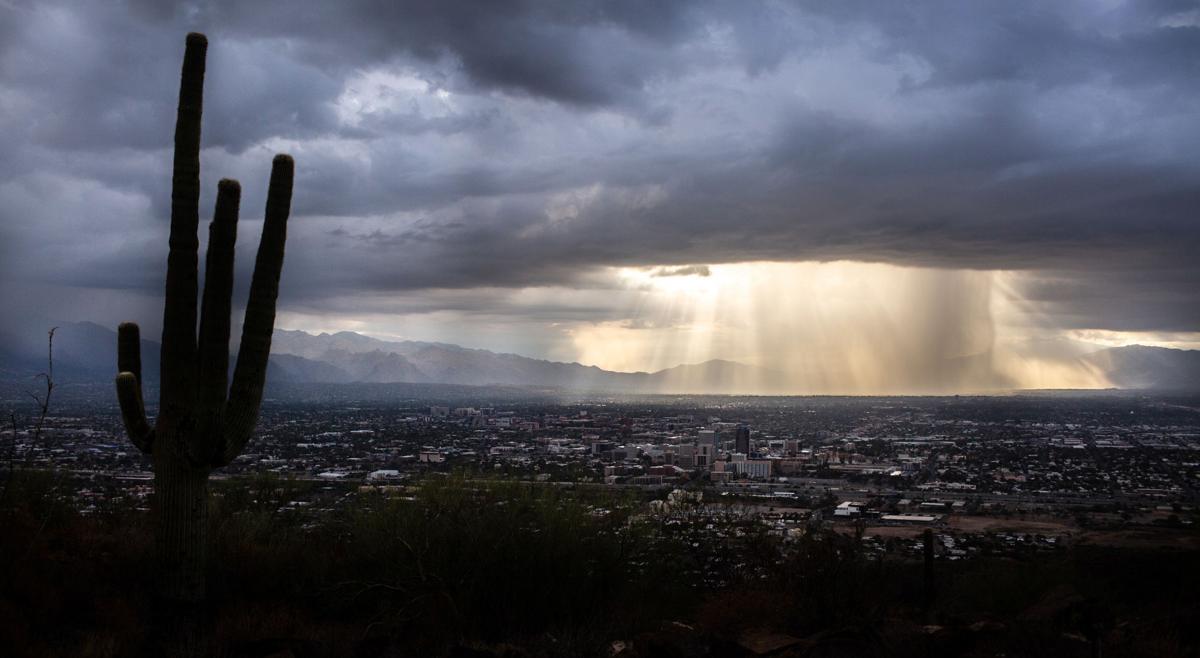Editor's note: This story was originally published on Aug. 2, 2020.
When the monsoon misses you, it’s hard not to take it personally. Even climate scientists sometimes feel the sting of rejection.
“The monsoon can be a very emotional thing, and I’m susceptible to that emotion, too,” said Mike Crimmins, a researcher and associate professor with the University of Arizona’s Department of Soil, Water and Environmental Science. “You just feel cheated every summer, because it’s not the summer you were hoping for.”
But that annual disappointment is probably just your memory playing tricks on you. According to preliminary results from a study now underway by Crimmins and his colleagues, there are no cursed locations in the Tucson area where summer rains consistently refuse to fall.
“Everyone thinks they have a doughnut hole in their part of the city,” he said. “We don’t see a systematic doughnut hole.”
What they see instead is a lot of variability, with some parts of town getting soaked one year and left largely dry the next. Basically, Tucson is a doughnut with a hole that moves around at random.
“It does show up during the monsoon season, but it’s not always in the same place,” Crimmins said. “And it isn’t there every monsoon season.”
“Luck is Probability taken personally”
Meteorologist Carl Cerniglia has a highly technical term for that: “dumb luck.”
“With any given event, you might see the west side picked on more or the east side picked on more,” said Cerniglia, who is with the National Weather Service in Tucson. “Proximity to terrain is the biggest influence.”
Since summer thunderstorms tend to form over mountains, people living closest to the Rincons and the Catalinas can generally expect “more precipitation in the long term,” he said. They also get more “snow events” in winter, but that’s more a function of elevation.
When it comes to monsoons, Cerniglia said, “There’s a basic pattern at play, and there’s a bit of dumb luck.”
And as famous magician and skeptic Penn Jillette is fond of saying: “Luck is probability taken personally.”
Which brings us back to the doughnut-hole question.
As part of his work at the university, Crimmins serves as an investigator for the National Oceanic and Atmospheric Administration’s Climate Assessment for the Southwest program, a Tucson-based regional collaboration between the UA and New Mexico State University.
He said he and his CLIMAS colleagues have talked about a study like this for several years, but they “turned up the gas” on the idea recently.
They’re now compiling and analyzing all of the available data from the last 20 years or so, from official weather service totals and gauge readings from the Pima County Regional Flood Control District to backyard rain observations from several volunteer networks, including one called Rainlog.org that Crimmins helped launch in 2005.

According to preliminary results from a study now underway by a local researcher, there are no cursed locations in the Tucson area where summer rains consistently refuse to fall.
He said the website might receive more than 300 rain reports during a particularly strong storm, but it relies on a core group of 15-20 amateur observers who submit their readings religiously every day, even when they have nothing to report but zeros. That information can be just as valuable, Crimmins said. “It’s one thing to know when it rains, but it’s just as important to have a record of when it doesn’t rain.”
bragging rights
The crew at CLIMAS also collects weather readings at their homes as kind of a “spectator sport,” Crimmins said. If they’re not bragging about their brimming rain gauges, they’re “rage observing,” as a storm skips them and dumps on someone else’s part of town.
So far this summer, Crimmins is getting creamed.
As of last week, this year’s monsoon had only produced about three-quarters of an inch of rain at his east-side home near Broadway and Camino Seco.
Meanwhile, backyard observers just 5 miles to the northwest of him have already soaked up a full 4 inches and counting.
“A part of town already has half of their annual rainfall, and it looks like the rest of us are going to struggle to catch up,” Crimmins said.
Of course, not all neighborhoods are created equal. Tucson is dotted with “microclimates” — subtle, local differences in temperature and humidity, based on terrain and other factors.
For example, the weather service’s Cerniglia said humidity levels tend to be higher in the area along the Santa Cruz River where Tucson’s treated effluent is released.
And there’s a slightly elevated stretch of Orange Grove Road that stays warmer at night and doesn’t dip below freezing as much in winter, which is why farmers used to grow citrus there, he said.
If it’s cold you’re looking for, Cerniglia said, Catalina State Park and Tanque Verde High School regularly see some of the lowest temperatures in the Tucson area, as cool air pours down from the Catalinas.
“Cold air is much like water. It follows the path of least resistance and seeks the lowest point,” he said. “Something to think about if you’re planning to move somewhere and you want to save a little money on air conditioning.”
The Tucson Fire Department said multiple agencies were responding to a swift water call along the Rillito River north of Tucson Mall on Thursday morning. The Northwest Fire District and Green Valley Fire District said they were also responding to several swift water rescues. More weather updates: http://tucne.ws/1fgo
Microclimates, major disappointments
Some microclimates are simply the result of land use. That’s why, on a typical sunny day, the temperature will be cooler in the grass at Randolph Golf Course than it is just across Broadway in the parking lot of El Con Mall.
Put enough parking lots, roads and buildings together in one place like that, and you get what’s known as the urban heat-island effect, which is driving up temperatures — particularly overnight lows — in Tucson, Phoenix, Las Vegas and other developing Southwestern cities.
Even in undisturbed desert, Crimmins said, changes in vegetation and soil color can alter the temperature and produce some microclimatic effects.
He said not much research has been done on the microclimates of Tucson, in part because studying them requires “dense networks of instrumentation.” Besides, there’s little evidence to suggest that such small, local variations have any measurable impact on the regional and global forces that drive Southern Arizona’s summer thunderstorm activity, he said.
In other words, microclimates are not to blame for the lousy monsoon we’ve seen so far this year.
But take heart, Tucson: Crimmins insists the stormy weather will return eventually, no matter what part of town you live in. “On average, over time, it does even out,” he said.
Before long, he expects to have a study to back him up on that. Crimmins said the CLIMAS team hopes to finish its analysis by next summer, just in time for monsoon season.
Farewell, monsoon season: Photos of the 2020 season in Tucson
Monsoon
Updated
The sun is caught between a monsoon storm cloud and the ridge of Roskruge Mountains west of Tucson, Ariz., September 1, 2020.
Monsoon
Updated
A pair of pedestrian dodge traffic, puddles and raindrops as rush across Euclid at 2nd Street during a monsoon rain which finally soaked the majority of the valley, Tucson, Ariz., August 29, 2020.
Monsoon
Updated
Passing traffic throws up a wake in the flooded intersection of Euclid and 2nd Street as monsoon finally lets loose some rain over the majority of the valley, Tucson, Ariz., August 29, 2020.
Monsoon
Updated
Traffic and a street car pass through the wet and shinny intersection of Congress and Granda as monsoon finally lets loose some rain over the majority of the valley, Tucson, Ariz., August 29, 2020.
Monsoon 2020
Updated
A woman walks along Grande Ave with her umbrella as sprinkles of rain drop after a monsoon storm rolled over Tucson on August 27, 2020.
Monsoon
Updated
Lightning strikes southeast of downtown as a monsoon storm puts on a light-show but misses with the rain again, Tucson, Ariz., August 22, 2020.
Monsoon
Updated
Scattered monsoon thunderstorms move around the valley dropping localized rain, winds and lightning but largely missing Tucson, Ariz., August 20, 2020.
Monsoon
Updated
Cloud lightning arcs over the valley as monsoon thunderstorms skirt the majority of Tucson, Ariz., August 20, 2020.
Monsoon
Updated
The sun sets on a little monsoon action, mostly contained to the southeast side of the valley, Tucson, Ariz., August 13, 2020.
Monsoon
Updated
A monsoon storm confined mostly to the east and southern parts of the valley, gets caught in the dying rays of the day's light, Tucson, Ariz., August 13, 2020.
Monsoon
Updated
Lightning strikes as a monsoon cell skirts the ranges to the west of the city shortly after sunset on Aug. 7, 2020. Tucson received 1.62 inches of rain during last year’s monsoon.
Monsoon
Updated
A highly localized monsoon cell skirts just to the west of the city with some rain and lightning just after the sun goes down, Tucson, Ariz., August 7, 2020.
Monsoon
Updated
A small patch of rain drops on Sombrero Peak northwest of the city as monsoon again flirts with Tucson, Ariz., August 7, 2020.
Monsoon
Updated
A rain column from a monsoon storms travels north, just west of the city, Tucson, Ariz., August 7, 2020.
Monsoon
Updated
A sundown monsoon storm skirts west of the city, just missing Tucson, Ariz., August 7, 2020.
Monsoon
Updated
No rain, just a few scattered monsoon clouds reflected in the windows of the former Hotel Arizona, 181 W. Broadway, before sun set over downtown, Tucson, Ariz., August 6, 2020.
Red sunset
Updated
Smoky skies from the Apple Fire in California make for a red tint over the sun, as seen from E. Speedway Blvd., in Tucson, Ariz. on August 2, 2020.
Monsoon
Updated
Lightning strikes the Santa Rita Mountains as traffic flows on Houghton Road after a monsoon storm picked up steam after passing through the east side just a bit of rain, Tucson, Ariz., July 31, 2020.
Monsoon
Updated
A monsoon storm drives some lighting into the Santa Rita Mountains and beyond just south of Tucson, Ariz., July 31, 2020.
Monsoon
Updated
A monsoon storm hits earth with several lighting bolts southwest of the Santa Rita Mountains and Elephant Head after largely by-passing Tucson, Ariz., July 31, 2020.
Monsoon
Updated
Several lighting bolts hit ground to the southwest of the Santa Rita Mountains and Elephant Head after a monsoon storm largely by-passed Tucson, Ariz., July 31, 2020.
Monsoon
Updated
A highly localized cell of monsoon dumps rain, with a hint of lightning, onto the Rincon Mountains as it sweeps through a small band of the eastern valley, Tucson, Ariz., July 28, 2020.
Monsoon
Updated
Monsoon clouds stripe the western just after a highly localized cell dropped rain on parts of Saguaro National Park East, Tucson, Ariz., July 28, 2020.
Monsoon
Updated
A half rainbow arcs over Saguaro National Park East as a highly localized cell of monsoon rain sweeps through a small band of the eastern valley, Tucson, Ariz., July 28, 2020.
Monsoon
Updated
A highly localized monsoon cell drops rain and rainbows on Saguaro National Park East as it sweeps over a small section of the Rincon Mountains and foothills, Tucson, Ariz., July 28, 2020.
Monsoon
Updated
Nighthawks weave through the sunset over the Rillito River, just barely running with the first significant monsoon rainfall of the season, Tucson, Ariz., July 23, 2020.
Monsoon
Updated
A mating pair of Couch's spadefoot toads deal with an interloper in the flowing Alamo Wash near the Rillito River with the first significant rainfall from monsoon, Tucson, Ariz., July 23, 2020.
Monsoon
Updated
A mating pair of Couch's spadefoot toads are among the hundreds out and active in the flowing Alamo Wash near the Rillito River following the first significant rainfall from monsoon, Tucson, Ariz., July 23, 2020.
Monsoon
Updated
A male Couch's spadefoot toad puffs up making a mating call as the first significant monsoon rainfall has the Alamo Wash flowing for a few hours, Tucson, Ariz., July 23, 2020.
Monsoon
Updated
A male Couch's spadefoot toad puffs up making a mating call as the first significant monsoon rainfall gets the wildlife out and active in the Alamo Wash, Tucson, Ariz., July 23, 2020.
Monsoon
Updated
A Couch's spadefoot toad lurks in the waters where the Alamo Wash feeds into the Rillito River with the first significant rainfall from monsoon, Tucson, Ariz., July 23, 2020.
Monsoon
Updated
The Santa Catalinas are reflected in the last yards of the flooded Alamo Wash just before it dumps into the Rillito River during the first significant monsoon rainfall, Tucson, Ariz., July 23, 2020.
Monsoon
Updated
The last trickles of the Alamo Wash dump into the Rillito River with the first significant rainfall from this year's monsoon, Tucson, Ariz., July 23, 2020.
Monsoon
Updated
A Couch's spadefoot toad plies the waters of the Alamo Wash just above the Riillito River following the first significant rainfall from monsoon this year, Tucson, Ariz., July 23, 2020.
Monsoon 2020
Updated
Dennis Ray helps a motorist whose car stalled at Ft. Lowell Road and Oracle Road after a monsoon storm passed over the Tucson area bringing heavy rain and flooding on July 23, 2020.
Monsoon 2020
Updated
A woman walks north along Oracle Road as a monsoon storm brings heavy rain and flooding on July 23, 2020. Tucson Police Department officers shut down Oracle Road north of Miracle Mile due to flooding at Oracle Road and Ft. Lowell Road.
Monsoon 2020
Updated
A man crosses the street at Ft. Lowell Road and Oracle Road after a monsoon storm passed over the Tucson area bringing heavy rain and flooding on July 23, 2020.
Monsoon 2020
Updated
The morning light breaks through rain clouds over the Rincon Mountains seen from Tumamoc Hill, on July 23, 2020.
Monsoon 2020
Updated
The shines through rain clouds over Tucson as seen from Tumamoc Hill, on July 23, 2020.
Monsoon 2020
Updated
A person carries an umbrella on their way up Tumamoc Hill, on July 23, 2020.
Monsoon 2020
Updated
Rain falls on the Santa Catalina Mountains as seen from Tumamoc Hill, on July 23, 2020.
Monsoon 2020
Updated
The morning light breaks through rain clouds over the Rincon Mountains seen from Tumamoc Hill, on July 23, 2020.
Monsoon 2020
Updated
Walkers shelter underneath their umbrellas as they make their way up Tumamoc Hill, on July 23, 2020.
Monsoon 2020
Updated
A truck driving south on Tucson Boulevard near Mitchell Street kicks up water following a monsoon, on July 23, 2020.
Monsoon 2020
Updated
Vehicles driving along Tucson Boulevard near Mitchell Street kick up water following a monsoon, on July 23, 2020.
Monsoon 2020
Updated
Water flows from a small wash into the Santa Cruz riverbed following monsoon rains near the Starr Pass Boulevard overpass, on July 23, 2020.
Monsoon 2020
Updated
People carry umbrellas as they walk along Dodge Boulevard near the intersection of Grant Street, on July 23, 2020.
Monsoon 2020
Updated
A double rainbow shows over a neighborhood street in Tucson, Ariz on July 15, 2020.
Monsoon 2020
Updated
Tucson sunset behind at Saguaro cactus on July 15, 2020.
Monsoon
Updated
An uprooted tree rests against one of the units in Mission Palms Apartments, 951 W. Orange Grove, victim of the first major monsoon storm of the season that rolled through the valley, Tucson, Ariz., July 11, 2020.
Monsoon
Updated
Looking for the perfect angle for a photo, Corey McCuin straddles the upper trunk of a tree uprooted the Mission Palms Apartments, 951 W. Orange Grove, in the first major monsoon storm of the season that hit, Tucson, Ariz., July 11, 2020. The tree was one of two that fell in the complex, this one uprooted a couple of steps to a second floor unit and landed in a mostly empty drive.
Monsoon
Updated
A rainbow shines in the last of the day's light over Saguaro National Park East first major monsoon storm of the season as it rolls west to wreak a bit of havoc in the valley, Tucson, Ariz., July 11, 2020.
Monsoon
Updated
A rainbow glows in the evening light over Saguaro National Park East, the first major monsoon storm of the season, Tucson, Ariz., July 11, 2020. The storm downed trees, power lines and brief heavy rain in the city.
Monsoon
Updated
Rainbows pop up over Saguaro National Park East, as the first major monsoon storm of the season begins to roll into the valley, Tucson, Ariz., July 11, 2020.\






